Prometheus and Grafan container deployment
Environmental description
| host name | IP |
| master | 192.168.58.110 |
| client | 192.168.58.20 |
Install docker on the master host
docker installation
Configure network source (rhel red hat system)
[root@master ~]# curl -o /etc/yum.repos.d/CentOS-Base.repo https://mirrors.aliyun.com/repo/Centos-8.repo
Configure docker CE source
[root@master ~]# cd /etc/yum.repos.d/ [root@master yum.repos.d]# curl -o docker-ce.repo https://mirrors.tuna.tsinghua.edu.cn/docker-ce/linux/centos/docker-ce.repo
Install docker CE and dependent packages and tools
[root@master ~]# dnf -y install yum-utils device-mapper-persistent-data lvm2 [root@master ~]# yum -y install docker-ce --allowerasing
After installation, use the docker version command to view the docker version information
[root@master ~]# docker version Client: Docker Engine - Community Version: 20.10.11 API version: 1.41 Go version: go1.16.9 Git commit: dea9396 Built: Thu Nov 18 00:36:58 2021 OS/Arch: linux/amd64 Context: default Experimental: true
Configure docker image acceleration
For personal accelerator links, please visit docker basic usage
[root@master ~]# mkdir -p /etc/docker
[root@master ~]# vim /etc/docker/daemon.json
{
"registry-mirrors": ["https://a74l47xi.mirror.aliyuncs.com "] / / the web address here is assigned by personal account
}
[root@master ~]# systemctl daemon-reload
[root@master ~]# systemctl restart docker
After configuration, pull the prom/Prometheus official image
[root@master ~]# docker pull prom/prometheus Using default tag: latest latest: Pulling from prom/prometheus 97518928ae5f: Pull complete 5b58818b7f48: Pull complete d9a64d9fd162: Pull complete 4e368e1b924c: Pull complete 867f7fdd92d9: Pull complete 387c55415012: Pull complete 07f94c8f51cd: Pull complete ce8cf00ff6aa: Pull complete e44858b5f948: Pull complete 4000fdbdd2a3: Pull complete Digest: sha256:18d94ae734accd66bccf22daed7bdb20c6b99aa0f2c687eea3ce4275fe275062 Status: Downloaded newer image for grafana/grafana:latest docker.io/prom/prometheus:latest [root@master ~]# docker images REPOSITORY TAG IMAGE ID CREATED SIZE prom/prometheus latest a3d385fc29f9 11 days ago 201MB
Get Prometheus. On the client YML profile
prometheus official
# Upload the installation package of prometheus to the host, unzip it, and download prometheus The yaml configuration file is transferred to the / opt directory of the master host [root@client ~]# ls anaconda-ks.cfg prometheus-2.31.1.linux-amd64.tar.gz [root@client ~]# tar xf prometheus-2.31.1.linux-amd64.tar.gz [root@client ~]# cd prometheus-2.31.1 [root@client prometheus-2.31.1]# scp /root/prometheus-2.31.1/prometheus.yml 192.168.58.110:/opt/prometheus.yml root@192.168.58.110's password: prometheus.yml 100% 934 29.3KB/s 00:00
Run the prometheus container using the official image and map the port and directory files
# View profile
[root@master ~]# cat /opt/prometheus.yml
# my global config
global:
scrape_interval: 15s # Set the scrape interval to every 15 seconds. Default is every 1 minute.
evaluation_interval: 15s # Evaluate rules every 15 seconds. The default is every 1 minute.
# scrape_timeout is set to the global default (10s).
# Alertmanager configuration
alerting:
alertmanagers:
- static_configs:
- targets:
# - alertmanager:9093
# Load rules once and periodically evaluate them according to the global 'evaluation_interval'.
rule_files:
# - "first_rules.yml"
# - "second_rules.yml"
# A scrape configuration containing exactly one endpoint to scrape:
# Here it's Prometheus itself.
scrape_configs:
# The job name is added as a label `job=<job_name>` to any timeseries scraped from this config.
- job_name: "prometheus"
# metrics_path defaults to '/metrics'
# scheme defaults to 'http'.
static_configs:
- targets: ["localhost:9090"]
# View mirror
[root@master ~]# docker images
REPOSITORY TAG IMAGE ID CREATED SIZE
prom/prometheus latest a3d385fc29f9 11 days ago 201MB
# Map ports and profiles to the host and set the container to start with docker startup
[root@master opt]# docker run -d --name prometheus --restart always -p 9090:9090 -v /opt/prometheus.yml:/etc/prometheus/prometheus.yml prom/prometheus
cb748d375af075241ea835c14a00896a8d94a3e05f911f8b88c155be9ae35980
[root@master opt]# docker ps | grep prometheus
cb748d375af0 prom/prometheus "/bin/prometheus --c..." 7 seconds ago Up 7 seconds 0.0.0.0:9090->9090/tcp, :::9090->9090/tcp prometheus
# View container running status
[root@master ~]# docker ps | grep prometheus
933b88601ed6 prom/prometheus "/bin/prometheus --c..." 10 minutes ago Up 10 minutes 0.0.0.0:9090->9090/tcp, :::9090->9090/tcp prometheus
Web access (ip+prot)
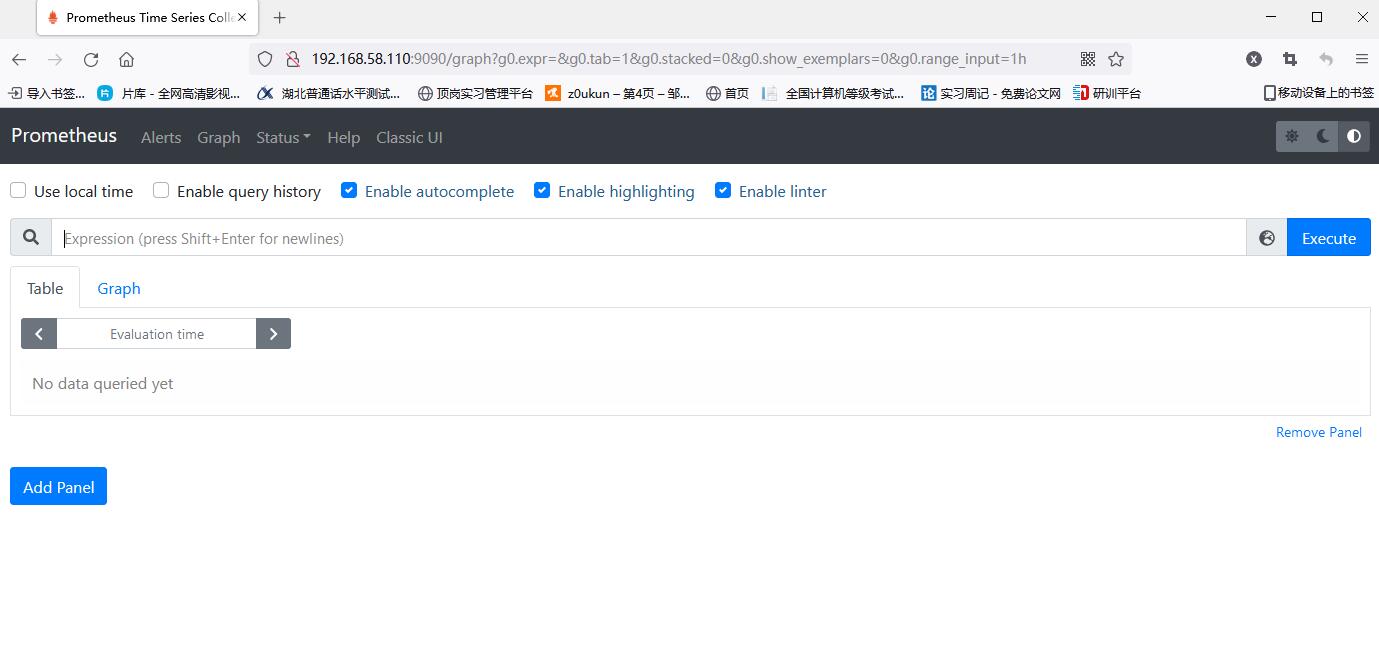
View the objects monitored by prometheus at this time
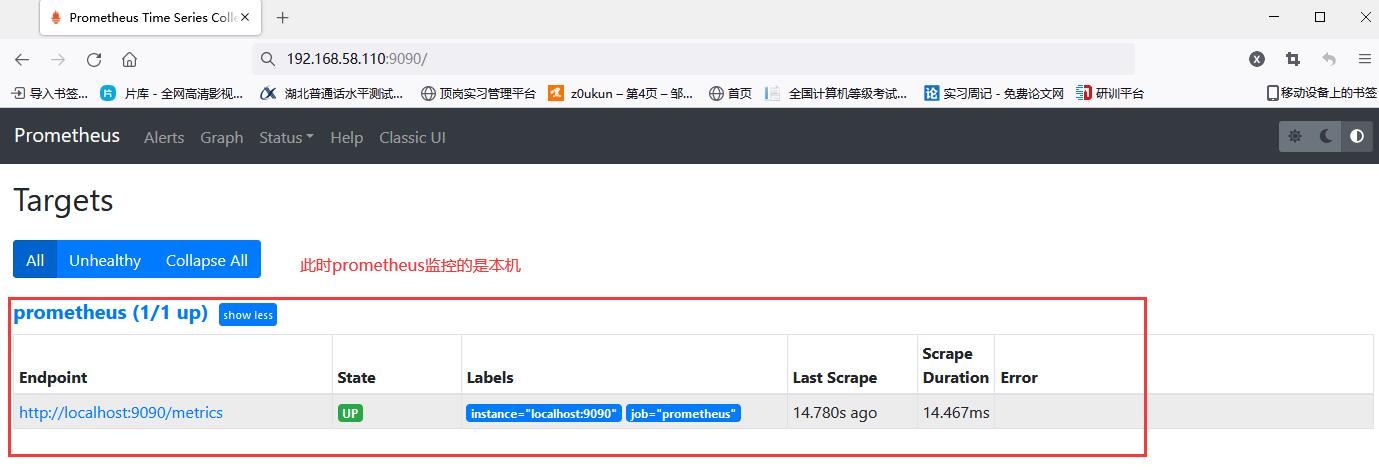
How to monitor other hosts (nodes)?
Prometheus can collect data from various components of Kubernetes cluster, such as cadvisor and API server in kubelet, and node export is one of the sources
Exporter is the general name of Prometheus data collection components. It is responsible for collecting data from the target and converting it into a format supported by Prometheus. Different from the traditional data acquisition component, it does not send data to the central server, but waits for the central server to crawl actively. The default crawl address is http://CURRENT_IP:9100/metrics
Node exporter is used to collect operation indicators at the server level, including basic monitoring such as loadavg, filesystem and meminfo of the machine, which is similar to ZABBIX agent in the traditional host monitoring dimension
Use the node exporter to collect information, and finally transmit the information to Prometheus, so as to realize the monitoring of different nodes.
Deploy node exporter on client host
Transfer the installation package to the client host, unzip it and rename it
[root@client ~]# ls anaconda-ks.cfg node_exporter-1.3.0.linux-amd64.tar.gz [root@client ~]# tar xf node_exporter-1.3.0.linux-amd64.tar.gz -C /usr/local/ [root@client ~]# cd /usr/local/ [root@client local]# ls bin etc games include lib lib64 libexec node_exporter-1.3.0.linux-amd64 prometheus sbin share src [root@client local]# mv node_exporter-1.3.0.linux-amd64/ node_exporter [root@client local]# ls bin etc games include lib lib64 libexec node_exporter prometheus sbin share src
Configure service file
[root@client ~]# vim /usr/lib/systemd/system/node_exporter.service [unit] Description=The node_exporter Server After=network.target [Service] ExecStart=/usr/local/node_exporter/node_exporter Restart=on-failure RestartSec=15s SyslogIdentifier=node_exporter [Install] WantedBy=multi-user.target # Set self starting node_exporter [root@client local]# systemctl daemon-reload && systemctl enable node_exporter && systemctl restart node_exporter Created symlink /etc/systemd/system/multi-user.target.wants/node_exporter.service → /usr/lib/systemd/system/node_exporter.service.
View port (default 9100 port)
[root@client ~]# ss -anlt State Recv-Q Send-Q Local Address:Port Peer Address:Port LISTEN 0 128 0.0.0.0:22 0.0.0.0:* LISTEN 0 128 [::]:22 [::]:* LISTEN 0 128 *:9100 *:*
Modify Prometheus. On the master host Yaml configuration file, adding nodes
[root@master ~]# vi /opt/prometheus.yml
# my global config
global:
scrape_interval: 15s # Set the scrape interval to every 15 seconds. Default is every 1 minute.
evaluation_interval: 15s # Evaluate rules every 15 seconds. The default is every 1 minute.
# scrape_timeout is set to the global default (10s).
# Alertmanager configuration
alerting:
alertmanagers:
- static_configs:
- targets:
# - alertmanager:9093
# Load rules once and periodically evaluate them according to the global 'evaluation_interval'.
rule_files:
# - "first_rules.yml"
# - "second_rules.yml"
# A scrape configuration containing exactly one endpoint to scrape:
# Here it's Prometheus itself.
scrape_configs:
# The job name is added as a label `job=<job_name>` to any timeseries scraped from this config.
- job_name: "prometheus"
# metrics_path defaults to '/metrics'
# scheme defaults to 'http'.
static_configs:
- targets: ["localhost:9090"]
- job_name: "Linux Server" //Add here
static_configs: //Add here
- targets: ["192.168.58.20:9100"] //Add here to add node_ Host IP of exporter + 9100
Restart container
[root@master ~]# systemctl restart docker [root@master ~]# docker ps | grep prometheus cb748d375af0 prom/prometheus "/bin/prometheus --c..." 3 minutes ago Up 3 seconds 0.0.0.0:9090->9090/tcp, :::9090->9090/tcp prometheus
Visit again to find new node information
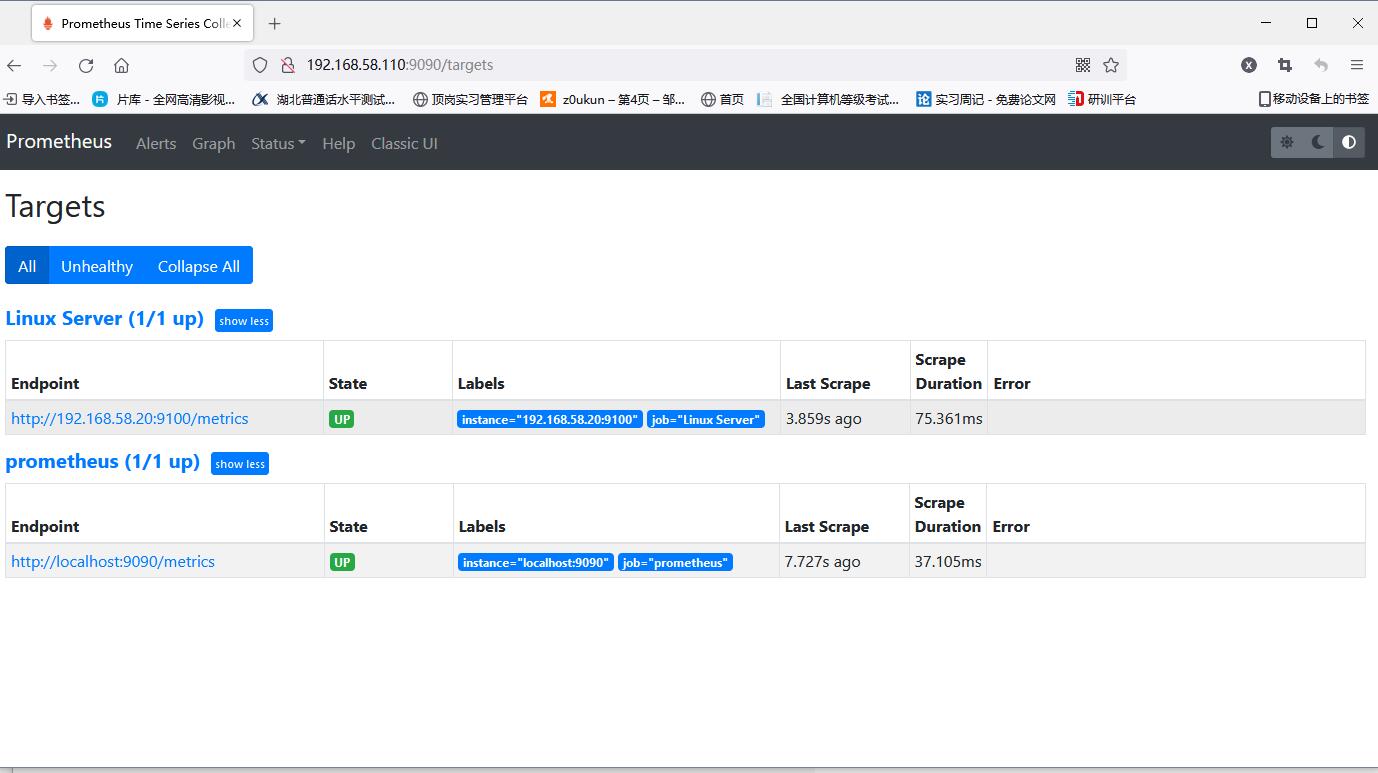
Use Grafan to visualize the monitored node information
Grafan container deployment
Pull the official image of grafan/grafan
[root@master ~]# docker pull grafana/grafana Using default tag: latest latest: Pulling from grafana/grafana 97518928ae5f: Pull complete 5b58818b7f48: Pull complete d9a64d9fd162: Pull complete 4e368e1b924c: Pull complete 867f7fdd92d9: Pull complete 387c55415012: Pull complete 07f94c8f51cd: Pull complete ce8cf00ff6aa: Pull complete e44858b5f948: Pull complete 4000fdbdd2a3: Pull complete Digest: sha256:18d94ae734accd66bccf22daed7bdb20c6b99aa0f2c687eea3ce4275fe275062 Status: Downloaded newer image for grafana/grafana:latest docker.io/grafana/grafana:latest
Run the grafan container using an image and map ports to provide services
[root@master ~]# docker images REPOSITORY TAG IMAGE ID CREATED SIZE prom/prometheus latest a3d385fc29f9 11 days ago 201MB grafana/grafana latest 9b957e098315 2 weeks ago 275MB [root@master ~]# docker run -dit --name grafan -p 3000:3000 grafana/grafana 2a068867c04d57aa67ece4d35f28e2a77f188c248de6a43bc071a9bb21aae417 [root@master ~]# docker ps | grep grafan 2a068867c04d grafana/grafana "/run.sh" 11 seconds ago Up 8 seconds 0.0.0.0:3000->3000/tcp, :::3000->3000/tcp grafan
Access home (ip+3000 port number)
The first time you log in, you need to change your password
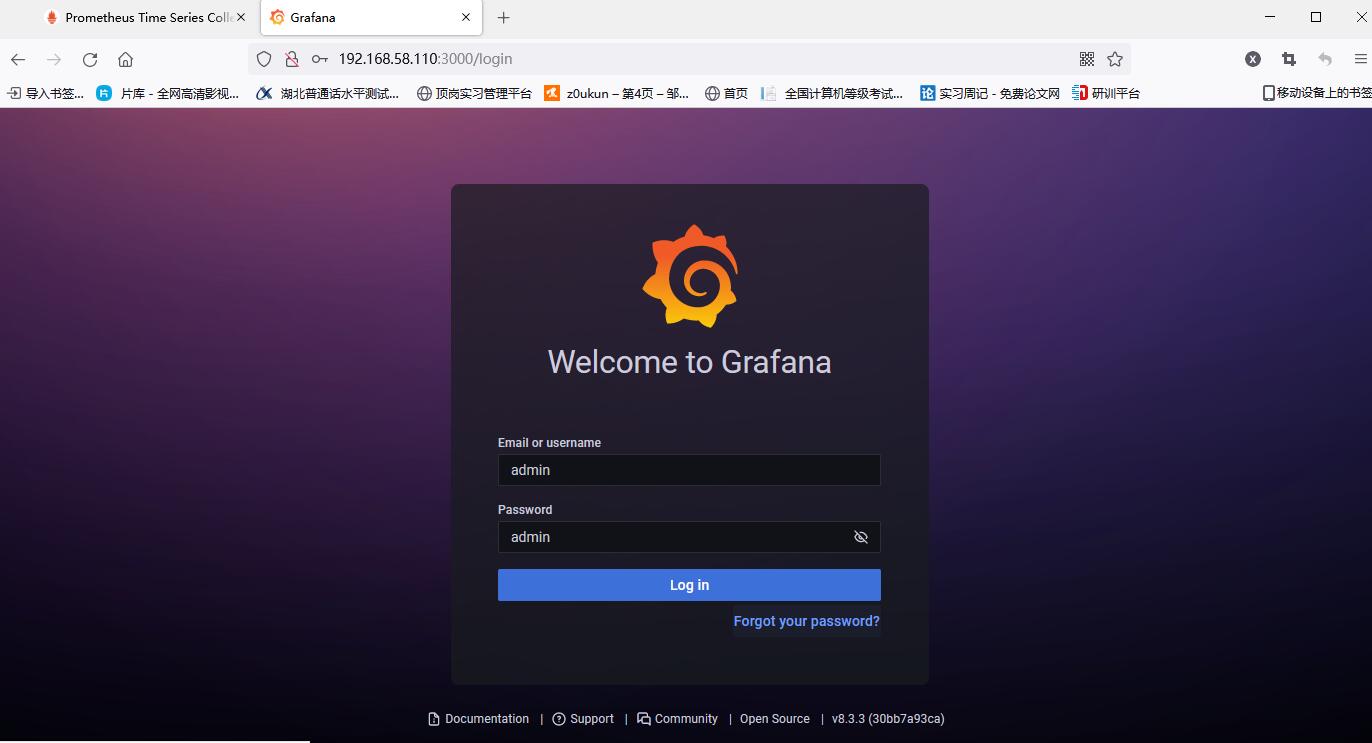
After changing the password, enter the home page
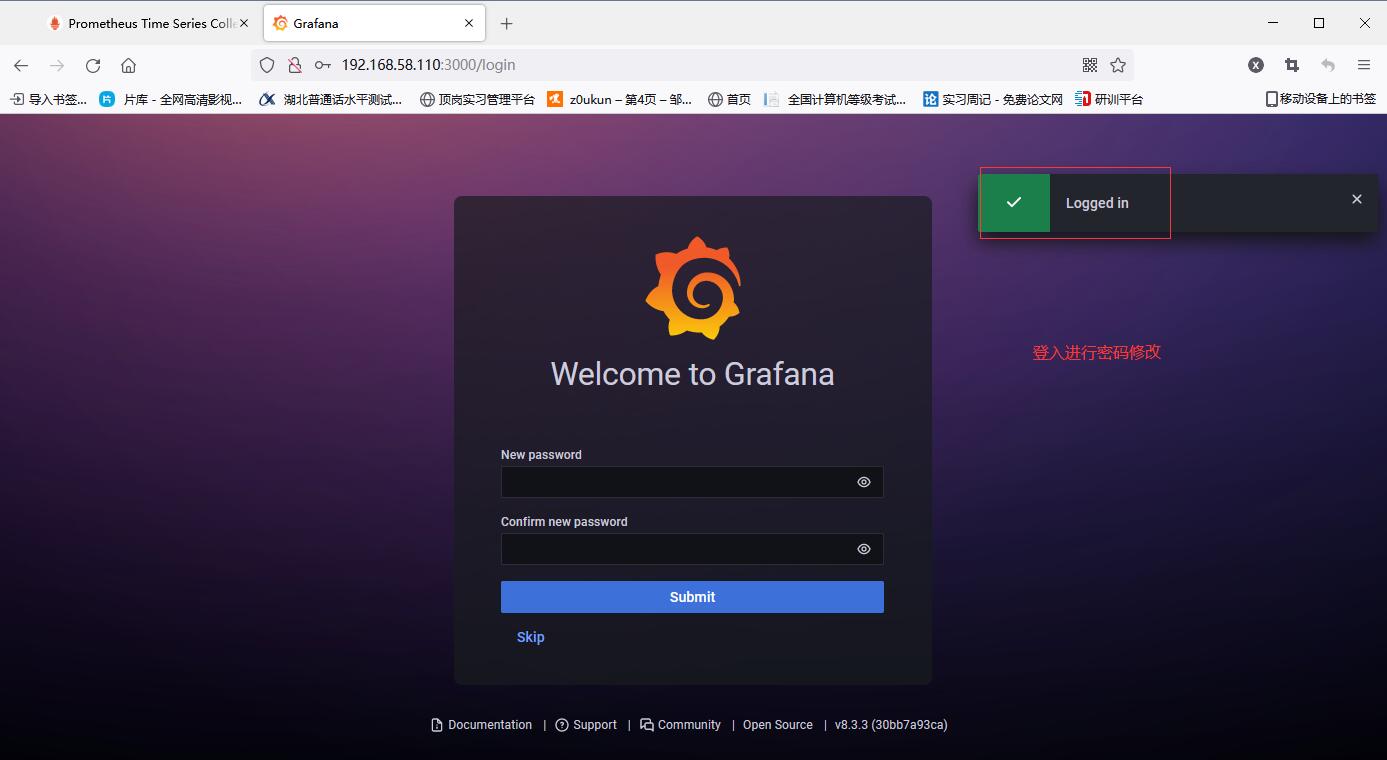
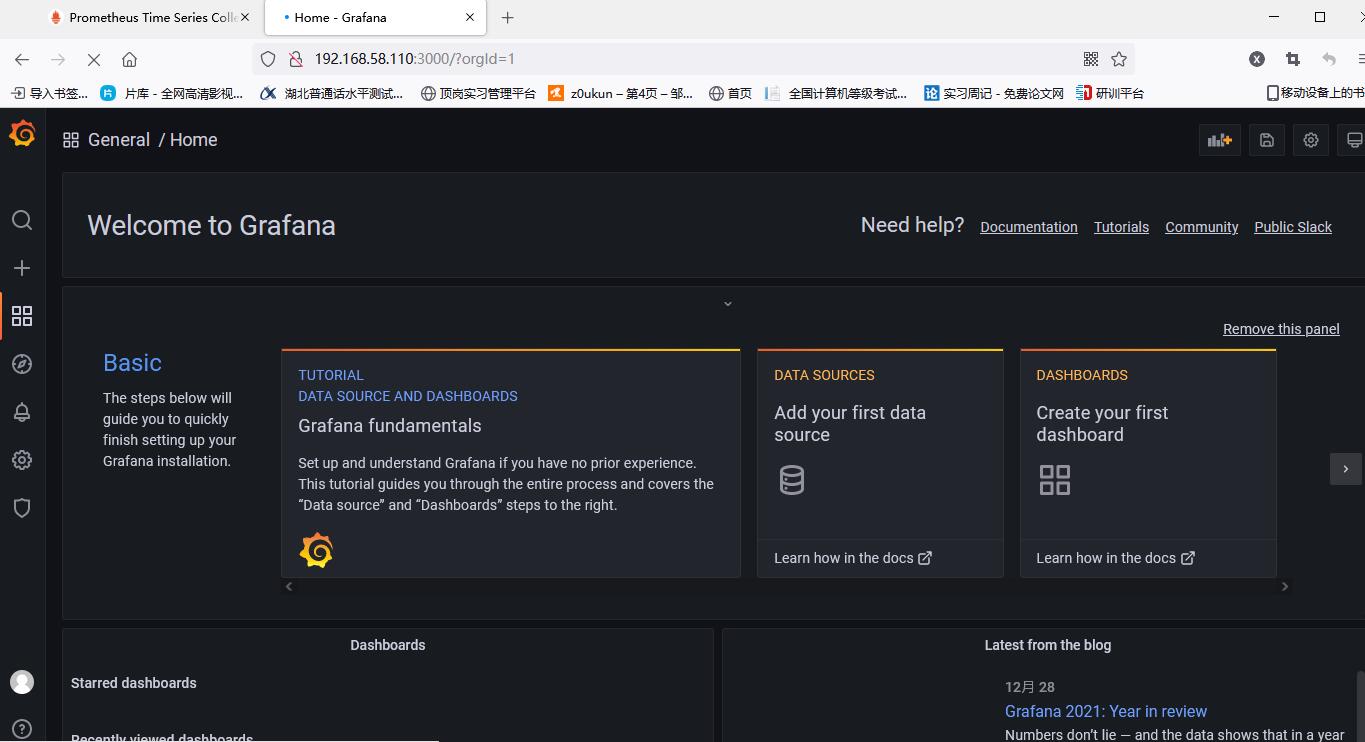
Add prometheus data source (that is, the access address of prometheus)
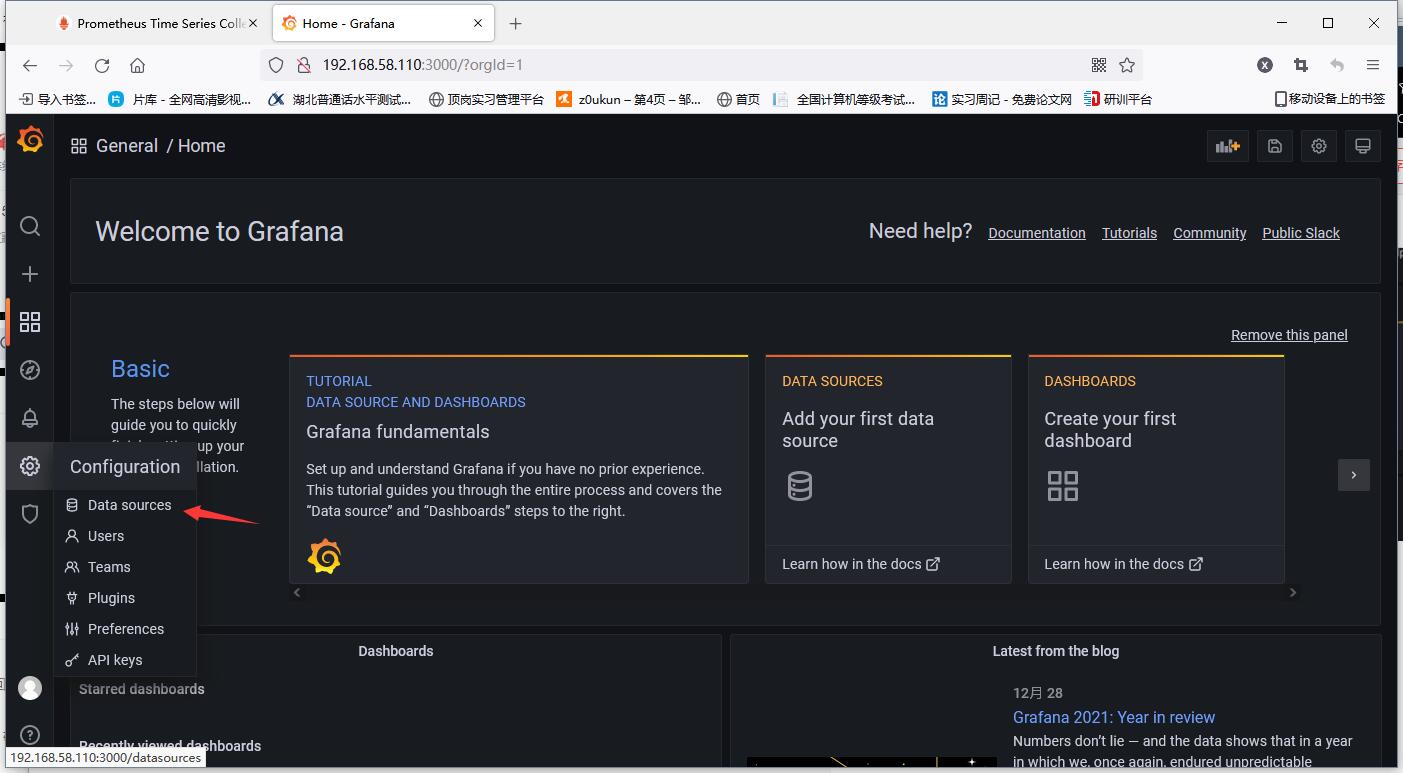

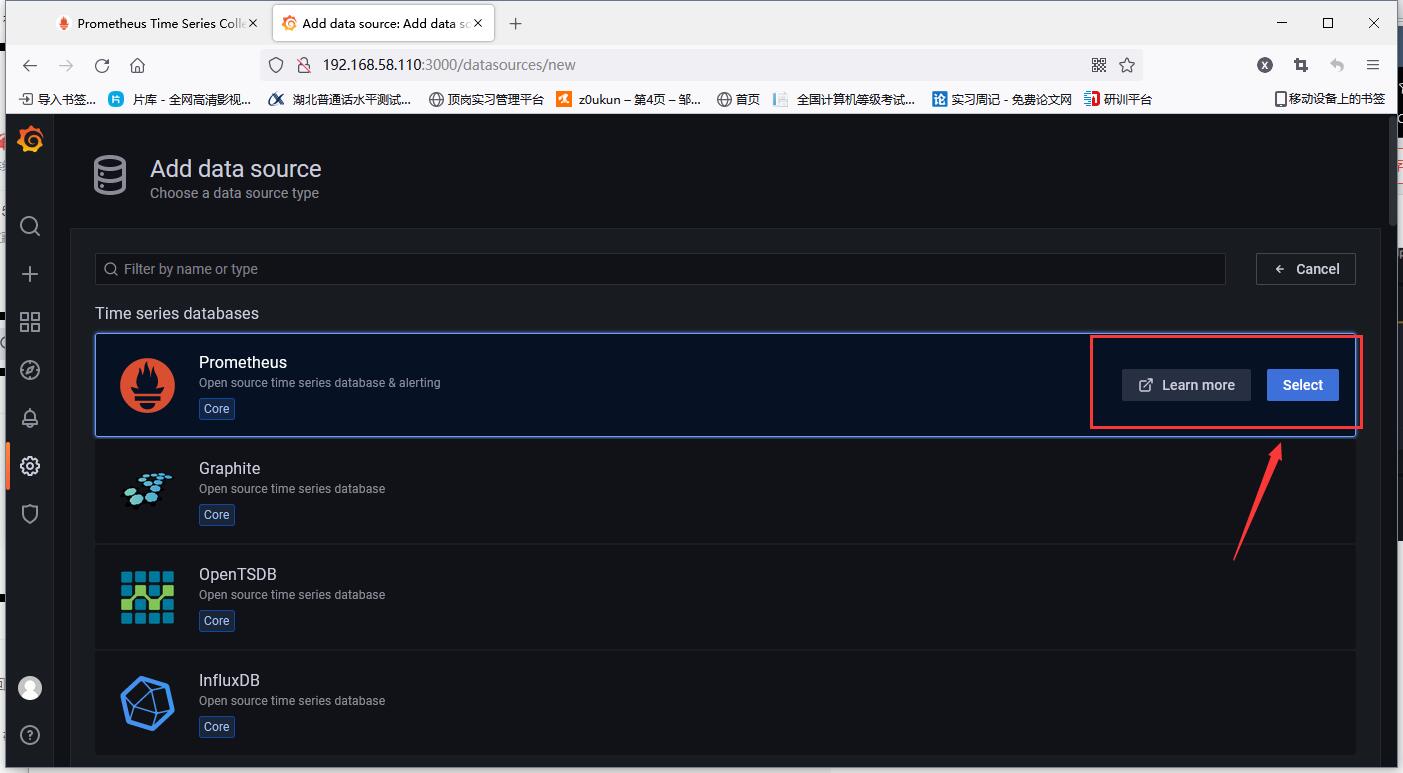
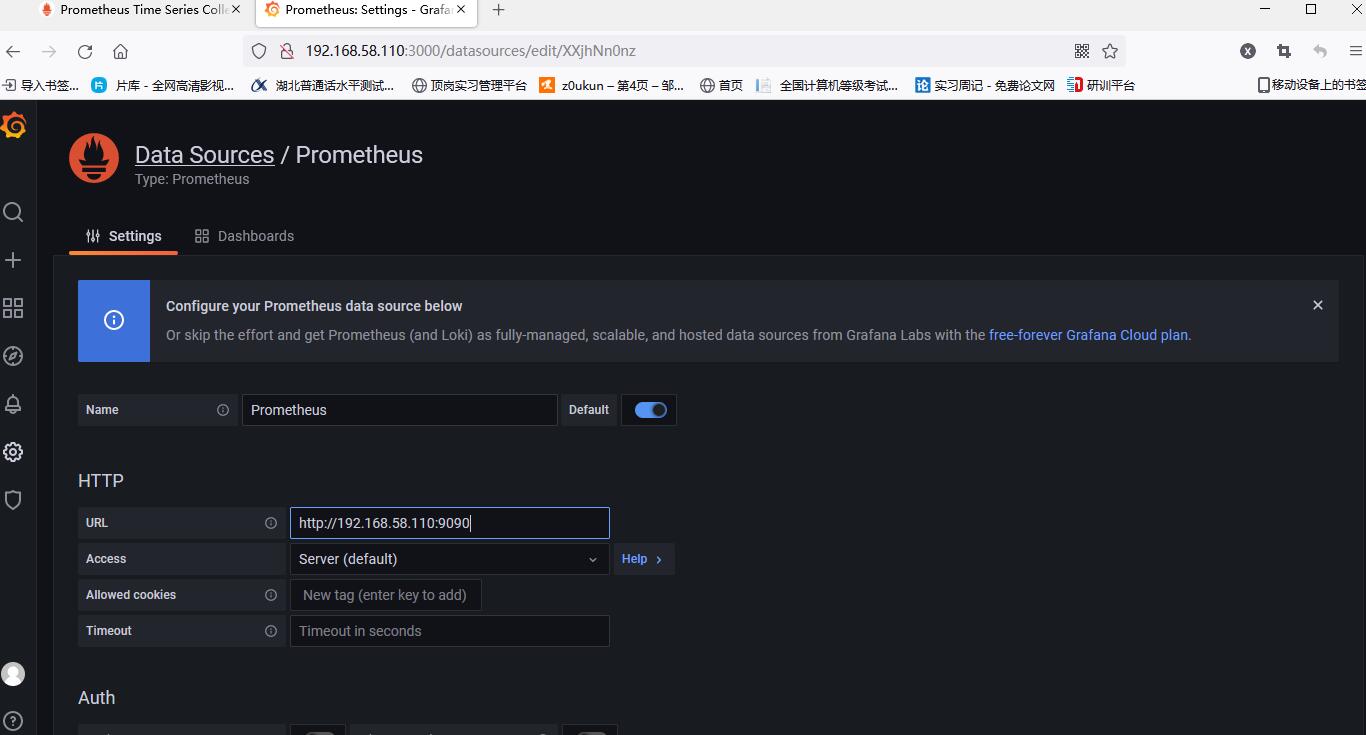
After filling in, tick down, click save and test
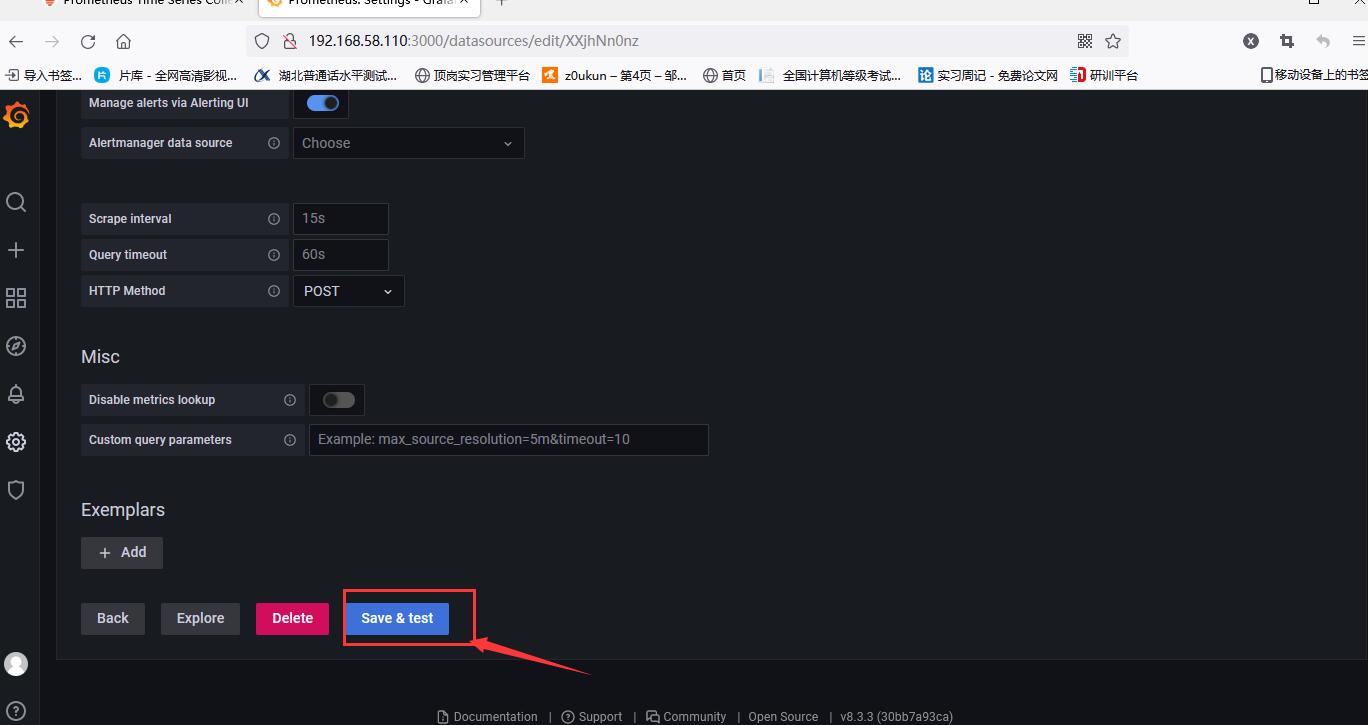
Import the chart after saving successfully
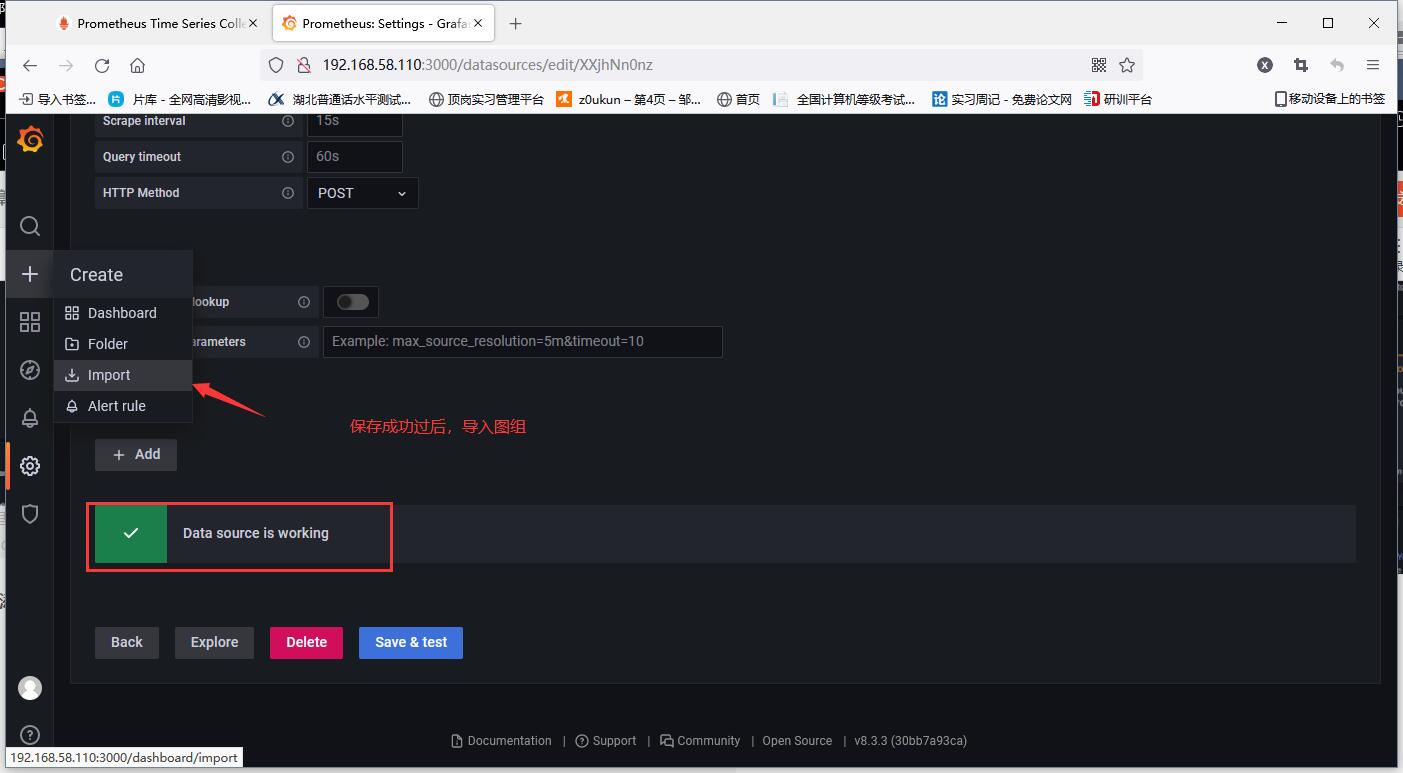

Select data source
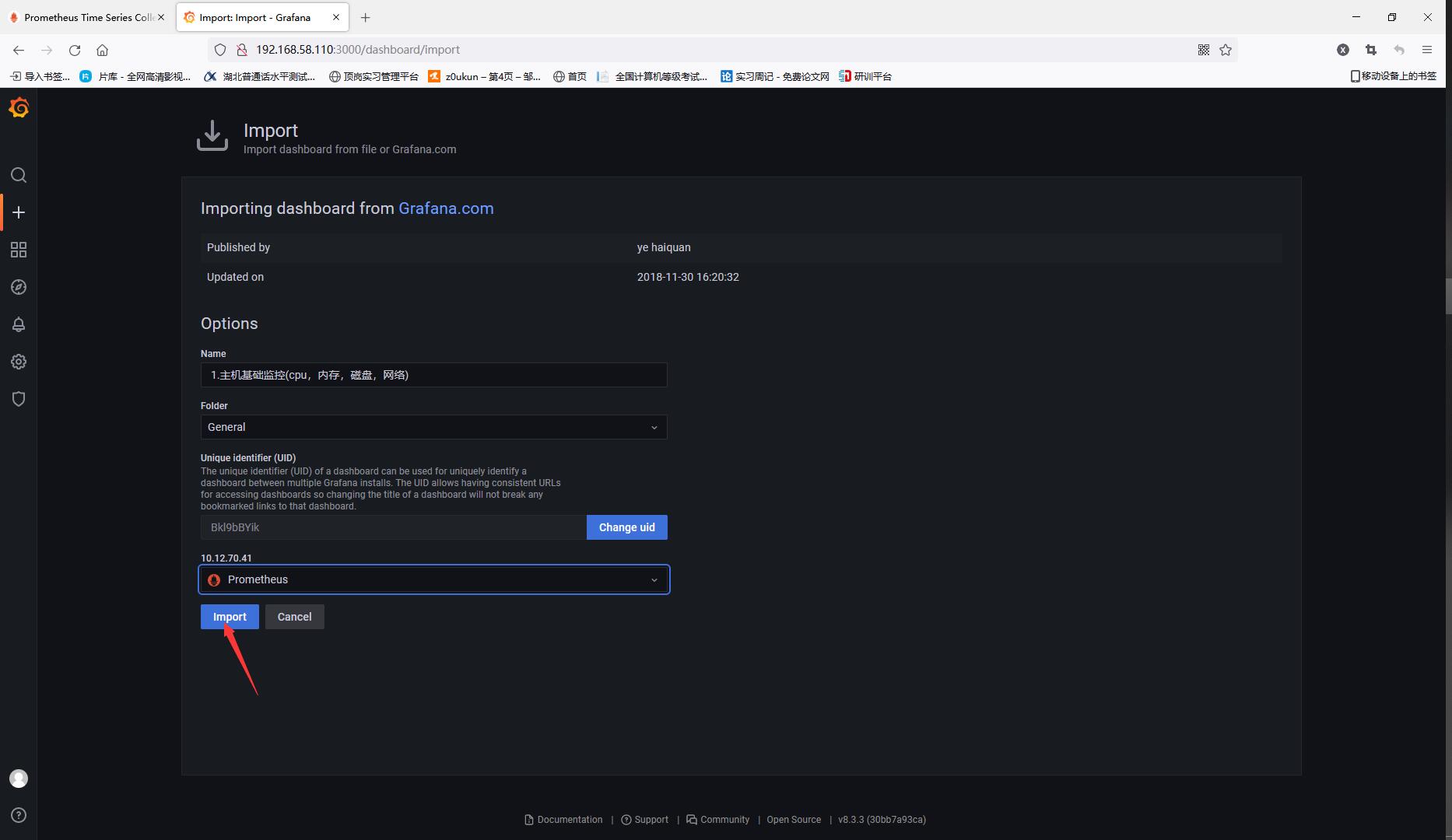
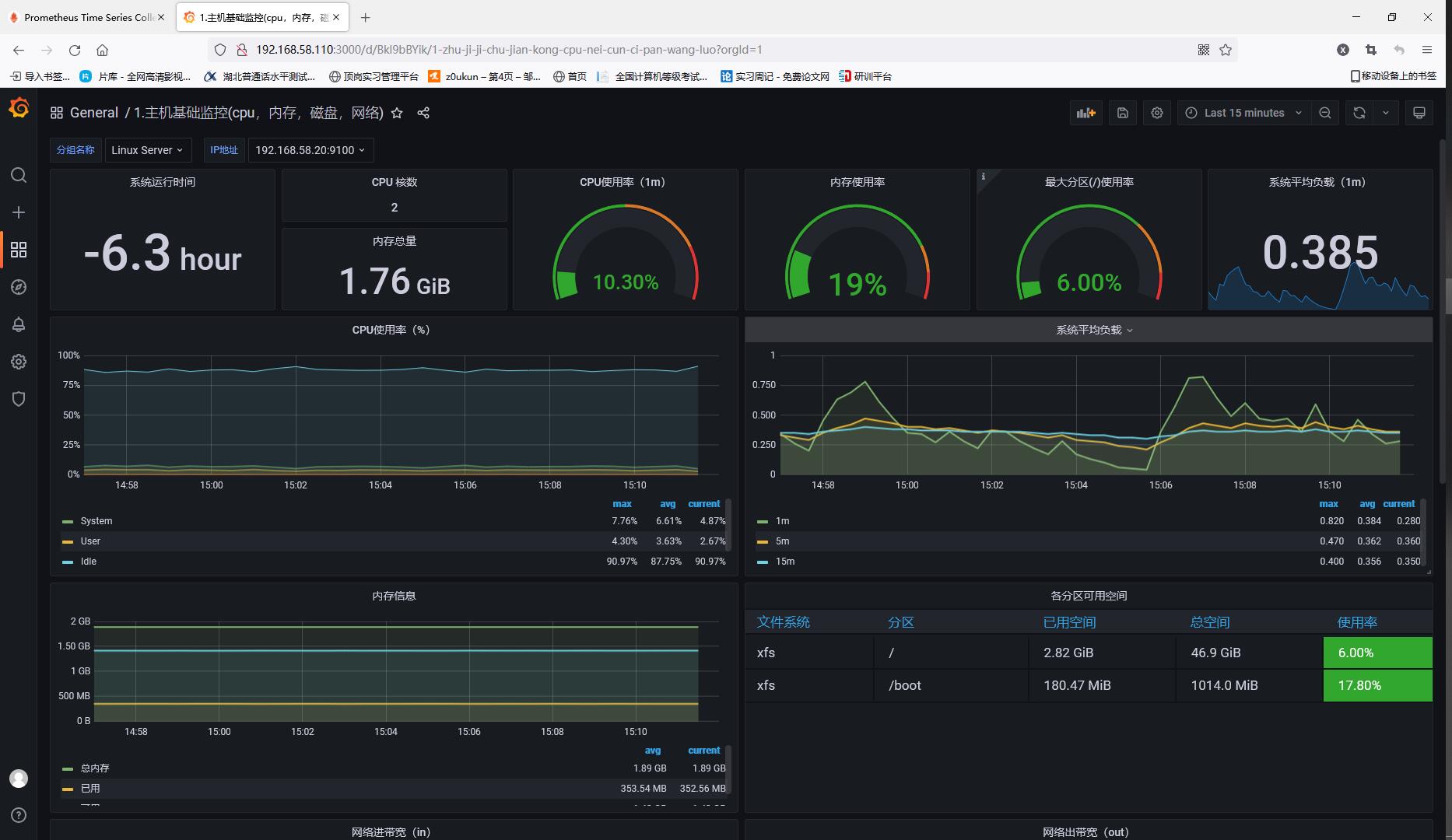
To customize grafan operations, please read Custom chart